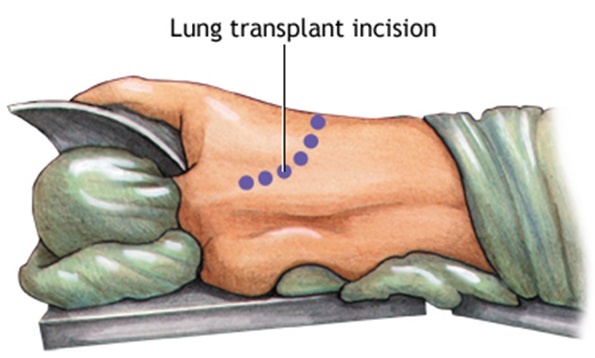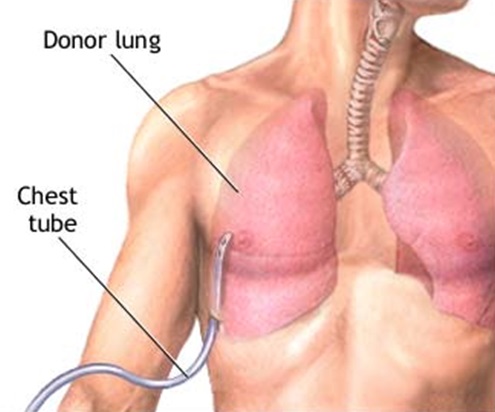Introduction
A lung transplant is a major procedure that is performed for patients with life-threatening lung disease or damage.
Lung transplantation, or pulmonary transplantation is a surgical procedure in which a patient’s diseased lungs are partially or totally replaced by lungs which come from a donor. Donor lungs can be retrieved from a living donor or a deceased donor. A living donor can only donate one lung lobe. With some lung diseases a recipient may only need to receive a single lung. With other lung diseases such as cystic fibrosis (a disease which is very rare in Malaysia), it is imperative that a recipient receives two lungs. While lung transplants carry certain associated risks, they can also extend life expectancy and enhance the quality of life for end-stage pulmonary patients.
Indications
The following are the indications for lung transplantation:
- Idiopathic pulmonary fibrosis
- End stage chronic obstructive pulmonary disease (COPD), including emphysema
- Cystic fibrosis
- Idiopathic (formerly known as “primary”) pulmonary hypertension;
- Alpha 1-antitrypsin deficiency
- Replacing previously transplanted lungs that have since failed;
- Other causes including lymphangioleiomyomatosis (LAM), bronchiectasis and sarcoidosis.
Contraindications
Lung transplant may not be done for patients who:
- Are too sick or badly nourished to go through the procedure
- Continue to smoke or abuse alcohol or other drugs
- Have active hepatitis B, hepatitis C, or HIV
- Have had cancer within the past 2 years
- Have lung disease that will likely affect the new lung
- Have severe disease of other organs
Procedure
Pre-Lung Transplantation
Before the procedure, the following shall be done to determine if a patient is a good candidate for the operation.
- Blood tests such as:
- A full blood count to ensure that the haemoglobin level is adequate and there is no infection
- Kidney and liver function
- Blood typing
- Tissue typing, to ensure that the patient’s body would not reject the donated lung
- Tests to evaluate the lung function
- Tests to evaluate the heart, such as echocardiogram (ECG), or cardiac catheterization (if necessary)
- Tests to look for early cancer (Pap smear, mammogram, colonoscopy)
- The patient should be less than 55 years
- The patient should have an acceptable psychological profile
- The patient should have a good social support system
- The patient should be financially able to pay for expenses (where medical care is paid for directly by the patient)
Good candidates for transplant are put on a national waiting list. A place on the waiting list is based on a number of factors, including:
- What type of lung problems a patient has
- The severity of the lung disease
- The likelihood that a transplant will be successful
For most adults, the amount of time spent on a waiting list usually does not determine how soon a patient gets a lung. Waiting time is often at least 2 – 3 years or more.
While waiting for a new lung, the patient should:
- Follow any diet that is recommended
- Stop drinking alcohol
- Stop smoking
- Weight should be kept in the recommended range
- Take all medicines as they were prescribed
- Follow any exercise program or pulmonary rehabilitation
- Keep any appointments made with the doctor and transplant team
- Make sure that they can be contacted easily if a lung becomes available
- Be prepared in advance to go to the hospital
During the Lung Transplant Surgery:
The patient is asleep and pain-free (under general anesthesia). A surgical cut is made in the chest. Lung transplant surgery is done with the use of a heart-lung machine. This device does the work of the heart while the heart is stopped for the surgery.
 |
| Source : http://www.adam.com/ |
- For single lung transplants, the cut is made on the side of the chest where the lung will be transplanted. The operation takes 4 – 8 hours. In most cases, the lung with the worst function is removed.
 |
| Source : http://www.adam.com/ |
- For double lung transplants, the cut is made below the breast and reaches to both sides of the chest. Surgery takes 6 – 12 hours. Tubes are used to send blood to a heart-lung bypass machine to provide oxygen and move blood through the body during the surgery.
After the cut is made, the major steps during lung transplant surgery include:
- One or both of the lungs are removed. For patients who are having a double lung transplant, most or all of the steps from the first transplant are completed before the second transplant is done.
- The main blood vessels and airway of the new lung are sewn to the blood vessels and airway. The donor lung is stitched (sutured) into place. Chest tubes are inserted to drain air, fluid, and blood out of the chest for several days to allow the lungs to fully re-expand.
 |
| Source : http://www.adam.com/ |
Sometimes, heart and lung transplants are done at the same time (heart-lung transplant) if the heart is also diseased.
Post-Lung Transplantation
The patient is expected to stay in the hospital for 7 – 21 days. Most of the time is spent in the intensive care unit (ICU) right after surgery. Most centers that perform lung transplants have standard ways of treating and managing lung transplant patients.
The recovery period is about 6 months. Often, the lung transplant team will ask the patient to stay close to the hospital for the first 3 months. The patient will need to have regular check-ups with blood tests and x-rays for many years.
The patient will also have to take medications to prevent rejection of the transplanted lung/s. These medications suppress the body’s immune response and reduce the chance of rejection.
Complications
This can happen early or late. The early complications are:
- Infection
- Heart failure
- Rejection of the transplanted lung
- Complications related to anti-rejection medication
- Cancers
- Death
Rehabilitation
This is an ongoing process and the patient is expected to perform. Pulmonary rehabilitation is continued. The rehabilitation process includes:
- Breathing and walking exercises
- Cardiopulmonary exercises
- Recommended diet is strictly adhered to
- Any form of infection is treated promptly
- Alcohol is prohibited
- Ensuring that the patient does not smoke
References
- Putnam JB. Lung, Chest Wall, Pleura, and Mediastinum. In: Townsend CM Jr, Beauchamp RD, Evers BM, Mattox KL, eds.Sabiston Textbook of Surgery
- Solomon M, Grasemann H, Keshavjee S. Pediatric lung transplantation. Pediatr Clin North Am
- Flume PA, Mogayzel PJ Jr, Robinson KA, Rosenblatt RL, Quittell L, Marshall BC; Clinical Practice Guidelines for Pulmonary Therapies Committee; Cystic Fibrosis Foundation Pulmonary Therapies Committee. Cystic fibrosis pulmonary guidelines: Pulmonary complications: hemoptysis and pneumothorax.Am J Respir Crit Care Med
- Kotloff RM. Lung transplantation. In: Mason RJ, Broaddus CV, Martin TR, et al.Murray & Nadel’s Textbook of Respiratory Medicine
| Last Reviewed | : | 13 November 2015 |
| Writer | : | Dr. Norhaya bt. Mohd Razali |
| Accreditor | : | Dr. Jamalul Azizi b. Abdul Rahaman |







